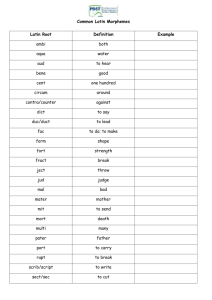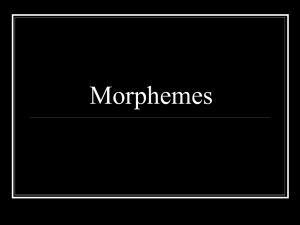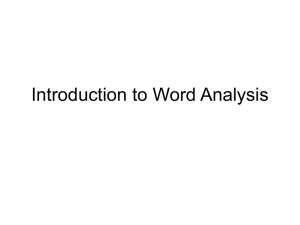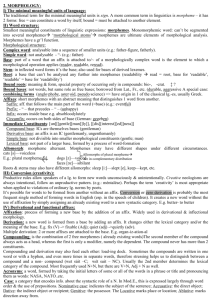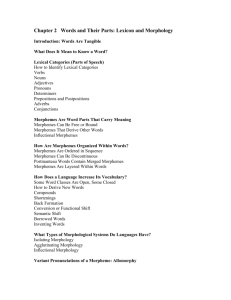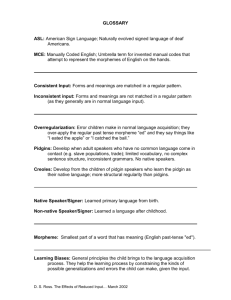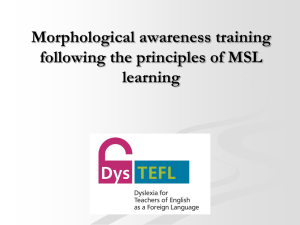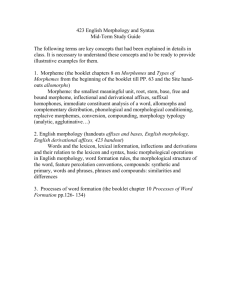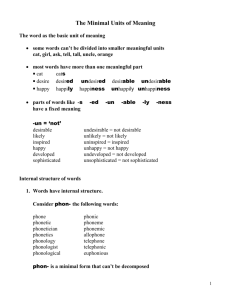Brown's Morphological Skills in Typically
advertisement
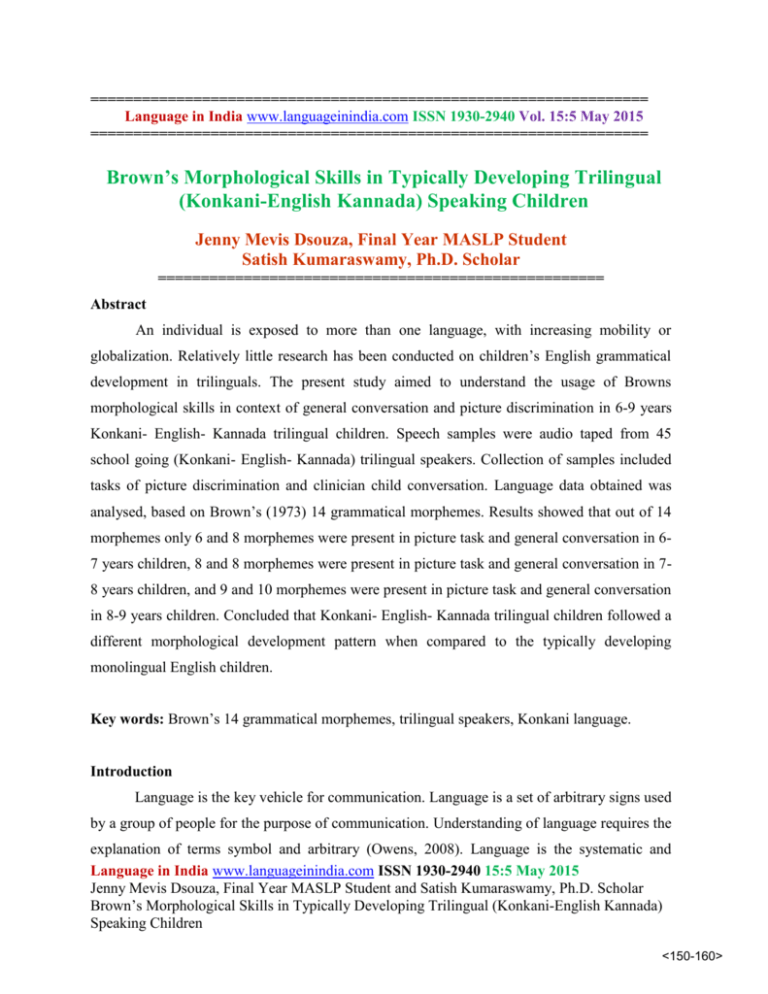
================================================================= Language in India www.languageinindia.com ISSN 1930-2940 Vol. 15:5 May 2015 ================================================================= Brown’s Morphological Skills in Typically Developing Trilingual (Konkani-English Kannada) Speaking Children Jenny Mevis Dsouza, Final Year MASLP Student Satish Kumaraswamy, Ph.D. Scholar ==================================================== Abstract An individual is exposed to more than one language, with increasing mobility or globalization. Relatively little research has been conducted on children’s English grammatical development in trilinguals. The present study aimed to understand the usage of Browns morphological skills in context of general conversation and picture discrimination in 6-9 years Konkani- English- Kannada trilingual children. Speech samples were audio taped from 45 school going (Konkani- English- Kannada) trilingual speakers. Collection of samples included tasks of picture discrimination and clinician child conversation. Language data obtained was analysed, based on Brown’s (1973) 14 grammatical morphemes. Results showed that out of 14 morphemes only 6 and 8 morphemes were present in picture task and general conversation in 67 years children, 8 and 8 morphemes were present in picture task and general conversation in 78 years children, and 9 and 10 morphemes were present in picture task and general conversation in 8-9 years children. Concluded that Konkani- English- Kannada trilingual children followed a different morphological development pattern when compared to the typically developing monolingual English children. Key words: Brown’s 14 grammatical morphemes, trilingual speakers, Konkani language. Introduction Language is the key vehicle for communication. Language is a set of arbitrary signs used by a group of people for the purpose of communication. Understanding of language requires the explanation of terms symbol and arbitrary (Owens, 2008). Language is the systematic and Language in India www.languageinindia.com ISSN 1930-2940 15:5 May 2015 Jenny Mevis Dsouza, Final Year MASLP Student and Satish Kumaraswamy, Ph.D. Scholar Brown’s Morphological Skills in Typically Developing Trilingual (Konkani-English Kannada) Speaking Children <150-160> conventional use of sounds for the purpose of communication on self- expression. Language is complex and multifaceted (Crystal, 1995). Morphology is the feature of language concerned with the rules governing change in word meaning. A morpheme is a word or part of a word that conveys meaning. Many words can be broken down into minor units that can be used to convey meaning. Grammatical morphemes such as the present progressive ‘– ing’, the regular past ‘–ed’ and the plural ‘-s’ are defined as “bound” in that’ they function as symbols or tags that are used to change the meaning when attached to a word. Other grammatical morphemes such as in’, ‘on’, ‘a’ and ‘the’ are described as “free” because they can stand alone, modifying another word but not attached to it. Grammatical morphemes are noticeably absent in children’s early word combinations. Children firstly use word order to convey meaning, even those children acquiring highly inflected languages. But as their mean length of utterances in morphemes (MLU) approaches 2.5, morphemes such as the past tense and plural inflections and prepositions such as in and on begin to appear. Soon after their first 50 words, at around 18 months of age, toddlers begin to combine words into two – word phrases. Between 2 and 5 years of age, pre-schoolers will develop the capability to use grammatical morphemes, produce basic grammatical sentence types and combine those into even more advanced grammatical structures. The emergence of these grammatical morphemes begins early in the preschool years. Although other important aspects of language are also emerging, as these grammatical morphemes gradually develop, the pre-schoolers’ language takes on a more mature, adult like texture. Dale (1980) indicated that the bilingual group exhibited a lower percent of accuracy across all morphemes when compared to the monolingual expectations. Paradis, Nichladis, Crago & Genesee (2011) argued that some differences in morphology might appear as errors in English as the second language, which is caused by the transfer of the grammatical rules from the child’s first language. Language in India www.languageinindia.com ISSN 1930-2940 15:5 May 2015 Jenny Mevis Dsouza, Final Year MASLP Student and Satish Kumaraswamy, Ph.D. Scholar Brown’s Morphological Skills in Typically Developing Trilingual (Konkani-English Kannada) Speaking Children <150-160> Steckol & Leonard (1979) studied grammatical morpheme usage of normal children and language impaired children matched at two different levels of mean length utterance length. The language impaired children displayed less grammatical morpheme usage than the normal children with equivalent mean utterance length. Varghese & Kumaraswamy (2013) studied browns morphological skills in KannadaEnglish bilinguals on 5-7 years children’s. Result revealed presence of 4 morphemes and absence of 8 morphemes. Varghese, Thomas, Nebu, Sunny & Kumaraswamy (2014) studied browns morphological skills in Malayalam- English bilinguals on 5-7 years children’s. Result showed that the presence of 6 morphemes in picture discrimination task and presence of 8 morphemes in general conversation task. Need of the Study Relatively little research has been conducted on children’s English grammatical development in trilinguals. Earlier studies focused on western languages. In the current study, we take a small step toward morphological development in Konkani- Kannada-English trilinguals. Speech language pathologists need to understand typical English third language acquisition and how it differs from bilingual and monolingual English in order to accurately assess and effectively identify potential language disorders as early as possible. Aim The aim of the study was to determine the order of acquisition of English morphological structures produced by Konkani- Kannada- English bilingual children and which morphological structures mastered by 6-9 years. Methodology The present study aimed to find which morphological structures were achieved by 6 -9 year (Konkani-English-Kannada) typically developing trilingual children. Language in India www.languageinindia.com ISSN 1930-2940 15:5 May 2015 Jenny Mevis Dsouza, Final Year MASLP Student and Satish Kumaraswamy, Ph.D. Scholar Brown’s Morphological Skills in Typically Developing Trilingual (Konkani-English Kannada) Speaking Children <150-160> 45 typically developing children further divided into three groups (15 each in the age range of 6-7, 7-8 and 8-9 years) participated in the present study. Inclusive Criteria As per school record and teachers input: Speaking Konkani as native language. English as second language. Kannada as third language. Attends English medium school since kindergarten. Exclusive Criteria No history of speech, language and hearing problem. No history of middle ear infections. No neurological deficit. Stimulus and Equipment Stimulus preparation was done based on the three experienced speech language pathologists view, six colour card were depicting the activities of school, home and playground were chosen for picture description task. A conversation sample between clinician- child and picture card description (school, playground and home) was recorded using PRAAT software 5.3 14 version (Boersma & Weenink, 2007). Procedure and Scoring Test was administered in a quiet room with adequate illumination. The subject was seated next to the examiner 1 foot distance in front of the standard notebook with inbuilt microphone. Child was asked to sit in a chair and six picture cards were given to him, one after the other which he had to describe the activities happened in the picture card. The instruction by the clinician was given in English for conversation sample and for picture description task. For Language in India www.languageinindia.com ISSN 1930-2940 15:5 May 2015 Jenny Mevis Dsouza, Final Year MASLP Student and Satish Kumaraswamy, Ph.D. Scholar Brown’s Morphological Skills in Typically Developing Trilingual (Konkani-English Kannada) Speaking Children <150-160> the above two task the client has to describe in full and meaningful sentence. If the participants were not able to say in complete sentence, semantic cues were given only once. A score of one for presence of morphemes and zero for absence was obtained. The audio recorded samples were transcribed using International Phonetic Alphabet (IPA) -5 and analysed for morphological structures. The data was statistically analysed using Kruskal Walli’s test to find the significant difference of morphemes present in trilinguals and as well as the pattern of the morphemic development to have a general idea about the trilingual Konkani – EnglishKannada speakers English morphemic development. The identified morphemes were compared with browns 14 stages and checked for order of acquisition and its relevance in KonkaniEnglish- Kannada trilinguals. Results and Discussion The aim of the present study was to determine which English morphemes were produced by 6- 9 years (Konkani-English-Kannada) typically developing trilingual children. Each subject’s utterances were analysed separately for the acquisition of 14 Brown’s morphological skills. The obtained data was statistically analysed and results were discussed below. Language in India www.languageinindia.com ISSN 1930-2940 15:5 May 2015 Jenny Mevis Dsouza, Final Year MASLP Student and Satish Kumaraswamy, Ph.D. Scholar Brown’s Morphological Skills in Typically Developing Trilingual (Konkani-English Kannada) Speaking Children <150-160> Task: Picture description Age group Present progressive – ing In On Plurals –s, es Past irregular- went Uncnttbl copula–am, is, are Possessive + s (mommy’ s) A, the (articles) Past irregular –ed, d, t rd 3 person regular (+s, talks, runs) rd 3 person irregular (does, has) Uncnctbl auxillary (am,is, are) Contractbl copula (m, ‘s, ‘re) Contracnl auxillary – ‘re (there running) N Mean SD Median Kruskal wallis test p value 6-7 7-8 8-9 6-7 7-8 8-9 6-7 7-8 8-9 6-7 7-8 8-9 6-7 7-8 8-9 6-7 7-8 8-9 6-7 7-8 8-9 6-7 7-8 8-9 6-7 7-8 8-9 6-7 7-8 8-9 6-7 7-8 8-9 6-7 7-8 8-9 6-7 7-8 8-9 15 15 15 15 15 15 15 15 15 15 15 15 15 15 15 15 15 15 15 15 15 15 15 15 15 15 15 15 15 15 15 15 15 15 15 15 15 15 15 15.07 22.60 24.60 .40 1.73 3.00 .00 .07 2.07 1.13 4.07 4.80 .00 .00 .20 6.60 15.00 19.80 .O7 .67 .13 1.20 9.80 16.80 .00 .00 .00 .00 .00 .00 .00 .00 .00 .00 1.13 1.73 .00 .00 .00 3.990 4.469 3.397 .737 1.486 1.690 .000 .258 1.668 1.246 1.870 2.624 .000 .000 .414 3.112 4.342 5.158 .258 .900 .516 1.656 5.493 9.872 .000 .000 .000 .000 .000 .000 .000 .000 .000 .000 2.264 2.939 .000 .000 .000 14.00 22.00 25.00 .00 2.00 2.00 .00 .00 2.00 1.00 5.00 5.00 .00 .00 .00 7.00 14.00 20.00 .00 .00 .00 1.00 8.00 18.00 .000 .000 .000 .000 .000 .000 .00 .00 .00 .00 .00 .00 .00 .00 .00 24.180 0.000 HS 19.7 0.00 HS 32.1 0.00 HS 21.014 0.00 HS 6.286 .043 SIG 31.503 .000 HS 7.571 .023 SIG 23.196 0.00 HS .000 1.000 HS .000 1.000 HS .000 1.000 HS 6.204 1.000 HS .000 1.000 HS 6-7 7-8 8-9 15 15 15 .00 .00 .00 .000 .000 .000 .00 .00 .00 .000 1.000 HS <150-160> Table 1: showing the mean and standard deviation of Brown’s morphemes for picture description task. From the above table it clearly shows that out of the 14 grammatical morphemes only nine morphemes showed highly significant difference ( p = .000) among three age groups and three morphemes having significant difference across three age groups. Present progressive (–ing) was observed to be an early developing morpheme. Out of nine morphemes, past irregular (- went) was the least used. Ty pe: General conv ersation: Present progressiv e – ing In On Plurals – s,es Past irregular- went, Uncntctbl copula- am, is, are, was Possessiv e + ‘s (m om my ’s) A, the ( art icles) Past irregular-ed, d,t 3rd person regular + s, talks, runs 3rd reson irregular (does, has) Uncntrbl auxillary ( am, is, are, has,hav e) Contracbl copula- (‘m, ‘s, ‘re), Cntracbl auxllry - -‘re (t hey re running) Age group 6--7 7--8 8 -- 9 6--7 7--8 8 -- 9 6--7 7--8 8 -- 9 6--7 7--8 8 -- 9 6--7 7--8 8 -- 9 6--7 7--8 8 -- 9 6--7 7--8 8 -- 9 6--7 7--8 8 -- 9 6--7 7--8 8 -- 9 6--7 7--8 8 -- 9 6--7 7--8 8 -- 9 6--7 7--8 8 -- 9 6--7 7--8 8 -- 9 6--7 7--8 8 -- 9 N 15 15 15 15 15 15 15 15 15 15 15 15 15 15 15 15 15 15 15 15 15 15 15 15 15 15 15 15 15 15 15 15 15 15 15 15 15 15 15 15 15 15 Mean 6.93 7.33 6.47 .33 1.87 1.93 .00 .33 .20 .33 1.27 .93 .00 .00 .93 1.33 3.13 2.07 1.33 1.53 2.13 .27 .87 1.00 .00 .00 .13 .0000 .0000 .0000 .0000 .0000 .0000 .07 .13 .33 .0000 .0000 .0000 .07 .00 .00 St d. Dev iation 3.305 3.374 3.137 .617 .990 1.387 .000 .617 .414 .617 1.335 .884 .000 .000 1.033 1.047 3.815 1.100 .900 1.125 .743 .594 1.246 1.309 .000 .000 .352 .00000 .00000 .00000 .00000 .00000 .00000 .258 .352 .724 .00000 .00000 .00000 .258 .000 .000 Median 7.00 7.00 6.00 .00 2.00 2.00 .00 .00 .00 .00 1.00 1.00 .00 .00 1.00 1.00 1.00 2.00 2.00 2.00 2.00 .00 .00 .00 .00 .00 .00 .0000 .0000 .0000 .0000 .0000 .0000 .00 .00 .00 .0000 .0000 .0000 .00 .00 .00 Kruskal wallis test .920 p .631 16.781 .000 HS 4.356 .113 5.649 .059 21.749 .000 HS 4.301 .116 6.044 .049 sig 3.177 .204 4.093 .129 .000 1.000 .000 1.000 1.338 .512 .000 1.000 2.000 .368 Table 2: showing the mean and standard deviation of evaluated Brown’s morphemes in general conversation task. From the above table it is evident that out of the 14 grammatical morphemes only three morphemes had highly significant difference (p = .000) among three age groups and Language in India www.languageinindia.com ISSN 1930-2940 15:5 May 2015 Jenny Mevis Dsouza, Final Year MASLP Student and Satish Kumaraswamy, Ph.D. Scholar Brown’s Morphological Skills in Typically Developing Trilingual (Konkani-English Kannada) Speaking Children <150-160> one morpheme possessive (-ing) shown significant difference between three age ranges. Present progressive (–ing) was observed to be an early developing morpheme. Out of nine used morphemes, past irregular (-ed, t) was the least used. Discussion The present study described about the presence of morphological structures achieved by 6-9 years trilingual (Konkani – Kannada- English) children. More specially, accuracy in production of Brown’s (1973) 14 grammatical morphemes were matched between Konkani – Kannada- English speaking children, who had been expected only to communicate in Konkani at home before entering kindergarten. Results showed that in picture description task out of 14 morphemes only 6 morphemes were used and for conversation task 8 morphemes were used by children in 6-7 age group, out of 14 morphemes only 8 and 8 were used in picture description and general conversation task in 7-8 years children, 9 and 10 morphemes were present in picture task and general conversation in 8-9 years children respectively which are in agreement with Bland- Stewart and Fitzgerald (2001). Summary and Conclusion Language is a complex and dynamic system of conventional symbols that is used in various modes for thought and communication. Contemporary views of human language holds that, language evolves within specific historical, social and cultural context; language is a rule governed behaviour described by a least five parameters phonologic, morphologic, syntactic, semantic and pragmatic language learning and use are determined by interaction of biological, cognitive, psychological and environmental factors (American Speech and Hearing Association, 1982). An individual is exposed to more than one language, with increasing mobility or globalization. Hence an individual must or should know more than one language i.e. be bilingual or multilingual to be an efficient communicator. Bilingualism means a person who knows more than one language (Mackay, 1962). The American Heritage Dictionary defines a trilingual person as someone who is using or able to use three languages, especially with equal fluency or nearly equal fluency. However differences in morphologic language development may be observed when considering children learning two languages. Under the Language in India www.languageinindia.com ISSN 1930-2940 15:5 May 2015 Jenny Mevis Dsouza, Final Year MASLP Student and Satish Kumaraswamy, Ph.D. Scholar Brown’s Morphological Skills in Typically Developing Trilingual (Konkani-English Kannada) Speaking Children <150-160> assumptions of a usage based theory of language acquisition (Tomasello, 2003) language input and age have important role for children’s morphologic language development. Relatively little research has been conducted on children’s English grammatical development in trilinguals. The present study aimed to understand the usage of Browns morphological skills in context of general conversation and picture discrimination in 6-9 years Konkani- English-Kannada trilingual children. Speech samples were audio taped from 45 school going (Konkani- English-Kannada) trilingual speakers. Collection of samples included tasks of picture discrimination and clinician child conversation. Language data obtained was analysed, based on Brown’s (1973) 14 grammatical morphemes. Statistical analysis was carried out further using Kruskalwalli test. Results showed that out of 14 morphemes only 6 and 8 morphemes were present in picture task and general conversation in 6-7 years children, 8 and 8 morphemes were present in picture task and general conversation in 7-8 years children, 9 and 10 morphemes were present in picture task and general conversation in 8-9 years children respectively which are in accordance with Blandstewart and Fitzgerald (2001). Konkani- English- Kannada trilingual children followed a different morphological development pattern when compared to the typically developing monolingual English children. Clinical Implications This data will be useful for speech language pathologists to understand typical English third language acquisition and how it differs from monolingual and bilingual English in order to accurately assess and effectively identify potential language disorders as early as possible. Also the results can be used to compare with language disordered group. Limitations Inadequate sample size. A wider age range would have yielded a more reliable result. Future Directions Study can be carried out across various Indian languages. Study can be carried across different language impaired population. ================================================================= Language in India www.languageinindia.com ISSN 1930-2940 15:5 May 2015 Jenny Mevis Dsouza, Final Year MASLP Student and Satish Kumaraswamy, Ph.D. Scholar Brown’s Morphological Skills in Typically Developing Trilingual (Konkani-English Kannada) Speaking Children <150-160> References American Speech Language Hearing Association. (1982). Language (Relevant paper). Retrieved from: www. asha.org/policy. Bland-Stewart, L. M., & Fitzgerald, S. M. (2001). Use of brown’s 14 grammatical morphemes by bilingual Hispanic pre-schoolers: a pilot study. Communication disorders quarterly, 22(4), 171-186. Boersma, P., & Weenink, D. (200). PRAAT, Doing Phonetics by computer (version 5. 3. 14). Computer software available from website: http//www. Praat.org. Brown, R. (1973). A first language: The early stages. Cambridge, MA: Harvard University Press. Carroll, D. (2008). Psychology of Language, fifth edition. Thomson learning, Inc. Crystal, D. (1995). The Cambridge Encyclopaedia of the English Language, U.K.: Cambridge University Press. Dale P. (1980). Acquisition of English and Spanish morphological rules by bilinguals, unpublished doctoral dissertation. University of Florida. Mackey, W. F. (1962). The description of bilingualism. Journal of linguistics, 7, 57-85. McLauglin. S. (1998). Introduction to language development. London: singular publishing group. Owens, R. E. (2008). Language development: An introduction. Boston, MA: Pearson. Paradis, J., & Genesee, F. (1996). Syntactic acquisition in bilingual children: Autonomous or interdependent? Studies in Second Language Acquisition, 18, 1–25. Language in India www.languageinindia.com ISSN 1930-2940 15:5 May 2015 Jenny Mevis Dsouza, Final Year MASLP Student and Satish Kumaraswamy, Ph.D. Scholar Brown’s Morphological Skills in Typically Developing Trilingual (Konkani-English Kannada) Speaking Children <150-160> Steckol, K.F., &Leonard, L. B. (1979). The grammatical morphology of Hebrew speaking children with specific language impairment: some competing hypothesis. Journal of Communication Disorders, 12(4), 291–301. Tomasello, G. R. (2003). Constructing a language. Cambridge: Harvard university press. Varghese, M. V., & Kumaraswamy, S. (2013). Brown’s morphological skills in typically developing (Kannada- English) speaking children. An unpublished dissertation, Mangalore University, India. Varghese, S. J., Thomas, E. D., Nebu, A., Sunny, S., & Kumaraswamy, S. (2014).Brown’s morphological skills in typically developing (Kannada- English) speaking children. Language in India, Language in India, 14, 139-150. ================================================================= Jenny Mevis D’souza Second year post graduate student Dr. M.V Shetty College of Speech and Hearing Maladi Court, Kavoor Mangalore – 575015 Karnataka India jennymavis1992@gmail.com Satish Kumaraswamy Principal Dr. M.V Shetty College of Speech and Hearing Maladi Court, Kavoor Mangalore – 575015 Karnataka India sat8378@yahoo.com Language in India www.languageinindia.com ISSN 1930-2940 15:5 May 2015 Jenny Mevis Dsouza, Final Year MASLP Student and Satish Kumaraswamy, Ph.D. Scholar Brown’s Morphological Skills in Typically Developing Trilingual (Konkani-English Kannada) Speaking Children <150-160>
